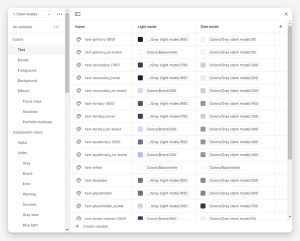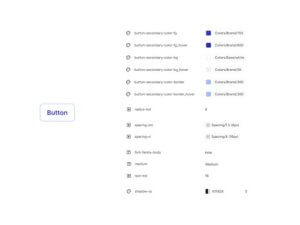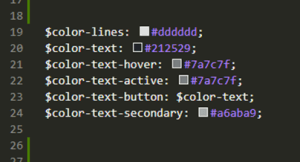The power of design tokens: the harmony between design and development

In the dynamic world of digital design, where end-user expectations are higher than ever, efficiency and consistency in the creation of digital products has become crucial. Tools such as Figma have revolutionised the way UX/UI designers collaborate with developers, facilitating the creation of flexible, consistent and scalable design systems. One aspect that has gained popularity in recent years is the use of Design Tokens, a concept that not only streamlines design workflows, but also improves communication and collaboration between design and development teams.
In this article, we will explore together what design tokens are and how they are transforming digital product development, why Figma is the ideal tool to apply them and how seamless collaboration between designers and developers can have a positive impact on digital product development. In addition, we will present some practical examples that demonstrate how the proper implementation of tokens can make projects much more efficient, cohesive and user-centric.
What are the Design Tokens?
Before going into detail about Design Tokens, it is important to understand the concept of a design system. A design system is a collection of reusable components, patterns and guidelines that enable the creation of digital interfaces in a consistent and efficient manner. With this in mind, Design Tokens are units of value that store key design attributes, such as the main colour of a brand or the size of text. These values are centralised and managed from a single location, allowing them to be automatically applied throughout the design system. Within these systems, Design Tokens play a key role by acting as the basis for defining visual and functional aspects such as colours, fonts, spacing and more.

Representation of how Design Tokens are displayed and managed in the Variables section of Figma.
Imagine you define a corporate colour for your entire brand. Instead of manually applying it to every button, header or background of your designs, you use a Design Token that stores this colour under a specific name (e.g. primary-colour or primaryColor). If you need to change the colour later, just modify the token value, and that change will automatically be reflected in all parts of the project. This not only saves time, but also ensures visual consistency at all points of interaction.
Advantages of using tokens in design
- Visual consistency: by working with tokens, we ensure visual consistency across all interaction points of the digital product. By changing a centralised value (such as the size of a font or the main colour), the entire system is updated automatically and instantly.
Practical example: Suppose a brand decides to update its corporate colour from #3498db to #1abc9c. Without tokens, every button, header and link would have to be changed manually, which would increase the likelihood of errors and inconsistencies. With tokens, it is enough to change the colour value in a single place for the change to be automatically reflected in all components. This way, we avoid visual inconsistencies and ensure that all parts of the product are aligned with the new design values.
- Improved collaboration between teams: tokens serve as a bridge between design and development, ensuring that both teams work with the same values and avoiding errors arising from miscommunication or misalignment. Practical example:
A designer defines the standard spacing between elements as 8px using a token called spacing-small. This same token can be referenced by the developer in the code, ensuring that the spacing is consistent throughout the product. This would avoid discrepancies between design and development, reducing unnecessary revisions and saving time.
- Agile scalability: in large or long-term projects, the ability to quickly update styles via tokens minimises revision times.
Practical example:
A digital product needs to add a dark theme. Instead of duplicating and redesigning each screen, tokens allow two sets of values to be defined (one for light and one for dark). Switching between themes is reduced to updating the token values, not redesigning the entire system.
- Time savings: the ability to update multiple elements at once minimises review and testing times, resulting in a faster and more efficient development process. Practical example:
A team needs to set all product text to a different typeface. Without tokens, each text instance would have to be located and changed manually. With tokens, simply change the font value in one place, and the change is automatically applied to the entire system. This would allow us to minimise repetitive tasks, reducing human error and speeding up product delivery times.

Breakdown of the Design Tokens that form the secondary button of a Design System.
Benefits for design and development teams
One of the most common challenges when producing digital products is the gap between the design team and the development team. However, by introducing the use of tokens, this gap becomes much narrower. Developers can use designer-defined tokens directly in the code, eliminating the need for manual style interpretations or conversions.
Benefits for designers
- Guaranteed visual consistency: tokens allow you to centralise key design values, such as colours, fonts or spacing. This ensures that all elements of the product maintain visual consistency in any update.
- Faster and more efficient iteration: thanks to tokens, designers can make global changes in a matter of seconds, speeding up revisions and allowing more time to be spent on strategic or creative tasks.
- Ease of adapting designs to different contexts: for projects requiring variations such as dark/light mode, internationalisation (longer or shorter texts) or specific platforms (mobile, web, tablet), tokens simplify customisation.
Benefits for developers
- Fewer implementation errors: By using tokens, designers and developers work with centralised values that eliminate any discrepancies between design and code. This reduces common errors, such as incorrect colour or font values.
- Increased workflow efficiency: tokens allow massive changes to be implemented with minimal effort, speeding up deliveries and minimising development times. For example, should a developer need to change the background colour of all buttons, the change would be massively and directly reflected in all instances of the button.
- Adaptability in scalable projects: tokens allow developers to efficiently manage large projects with multiple versions or platforms, without duplicating efforts.

Example lines of code with tokens.
Case studies
- Rebranding: let’s imagine that a company decides to rebrand, changing their colour palette and fonts. If they did not use tokens, the development team would have to manually update each style in the code, a lengthy and error-prone process. However, if the tokens were defined correctly from the beginning, they could change the token value once and all changes would be reflected immediately in the code.
- Implementing dark and light themes: In projects that require different themes (such as light and dark mode), the use of tokens facilitates the implementation of the theme. By defining a set of tokens for each theme, developers can switch between themes by changing only the token values, rather than rewriting entire styles.
- Scalable design for multiple platforms: In digital products that are produced for multiple platforms (web, mobile, etc.), the use of tokens allows developers to easily adapt styles to each platform without compromising design consistency.
Impact on product and business performance
The use of design tokens not only reinforces equipment efficiency and visual consistency, but is also key to the product and the business:
- Scalability: the implementation of tokens makes it possible to manage large-scale design changes quickly, reducing the time needed to introduce new functionalities or adapt the product to different markets.
- Cost reduction: by minimising errors and simplifying implementation processes, teams save time and resources, which directly impacts the cost-effectiveness of design and development.
- User retention: a coherent and optimised design not only improves usability, but also reinforces the perception of quality and trust, which increases user satisfaction and loyalty.
Conclusion
In an increasingly demanding digital environment, tools and methodologies that promote efficiency and collaboration between designers and developers are essential to the success of digital products. Design tokens, when implemented correctly in tools such as Figma, not only improve visual consistency, but also streamline development and enable better communication between teams. At Pasiona, we believe that implementing these advanced practices not only improves visual results, but also allows us to offer our clients more efficient and user-centric products. User-optimised design is at the core of everything we do. Design tokens are a key tool for improving the efficiency and consistency of digital products, but this is just the beginning. This approach is constantly evolving, and now is the perfect time to step into this world and position yourself at the forefront of digital design innovation. At Pasiona, we are here to help you implement these advanced solutions and take your digital projects to the next level. Together, we can bring real value to your project, ensuring not only a more efficient and attractive design, but also a user experience that makes a difference in the market. Do you want to boost your project? Don’t hesitate to contact us so that we can advise you.
agile tools, Design Tokens, project efficiency, project management, project planning, teamcollaboration
Go back



